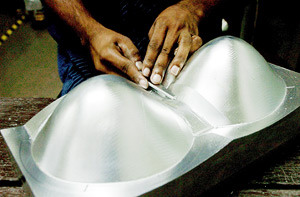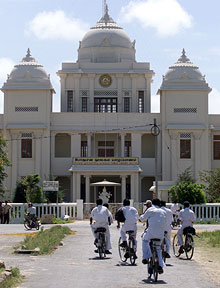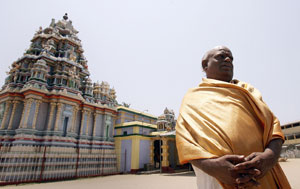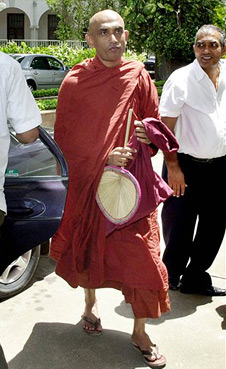Ilankai Tamil Sangam30th Year on the Web Association of Tamils of Sri Lanka in the USA |
||||||||||
 Home Home Archives Archives |
Lingerie and TerrorThe war laps at Sri Lanka's prosperous southby BBC, May 30, 2008
Friday I AM standing amid soft mounds of Victoria's Secret underwear, in a room with 1,000 young women. Engaging, if faintly intimidating, as this may be for me, it is even better for Sri Lanka. The women at this factory are employed by MAS Holdings, the biggest foreign supplier to Victoria's Secret, a label of American-based Limited Brands. MAS also makes lingerie and swimwear for Nike, Adidas and Britain’s biggest rag-trader, Marks & Spencer. MAS's 45,000 employees turn out 30m bras and 120m pairs of knickers a year. Last year the company had revenues of $700m. It is much the biggest player in an industry that accounts for 40% of Sri Lanka's exports and 10% of GDP.
Its success has also been rapid. Since the firm was founded in 1986—by three Muslim brothers, whose combined initials give MAS its name—it has grown by 20-30% a year by investing in high-value manufacturing. With few natural resources found locally—for example, Sri Lanka has no oil and grows no cotton—its textile companies cannot compete with China’s or Bangladesh’s on price. But Sri Lanka’s workforce is skilled and educated, able to make intricate pants of the highest quality. Sri Lankan workers have done well abroad, too. Remittances from overseas, mainly from the Gulf, fed $2.5 billion into the economy last year. A colonial inheritance, tea, is another solid earner; and so, despite the Air Tigers' best efforts is tourism. These industries have made Sri Lanka one of South Asia’s richest countries, with GDP per person at $4,100, based on purchasing-power parity. That is almost twice the equivalent figure for India. That this prosperity has been built during a quarter century of civil war is remarkable. Then again, it also suggests what an inequitable place Sri Lanka really is. Last year, as fighting raged in the north and east, displacing over 200,000 people, the Sri Lankan economy grew by a feisty 6.8%. By some estimates, that is 2% less than it would have grown without the war. Moreover, with the growth centred in Colombo, an ethnically-mixed capital, every sort of Sri Lankan will have benefited from the boom. Nonetheless, to those stuck in the war zone, caught between two clumsy foes, the prosperity of the south is yet another reason for grievance. For those in the south, who are mainly Sinhalese (as, presumably, are most of the hardworking women in MAS's factory), the war is too distant to cause much pain. Repelled by the Tigers' terrorism, and with little sympathy for Tamil grievances, most Sinhalese support the government in its campaign to obliterate the LTTE. According to a recent poll by the Centre for Policy Alternatives, a think-tank, only 16% of Sinhalese think the government should negotiate with the Tigers. But two factors could temper this bellicosity. One might be if the Tigers, in retaliation for the government's daily attacks, ramped up their terrorism in the south. There are already signs of this happening, including a flurry of bombs on buses and trains in recent weeks. But most pundits consider that the LTTE has, by its grisly standards, been somewhat restrained. It may be trying to throw a spotlight onto the government's abuses. Anyway, that spotlight has been cast. A slew of reports by reliable human-rights investigators have implicated the government in murder and other cruelty. In its 2007 human-rights assessment, the US State Department wrote: “Credible reports cited unlawful killings by government agents, assassinations by unknown perpetrators, politically motivated killings and child soldier recruitment by paramilitary forces associated with the government.” The government's response to this has been depressing. It has spat scorn at its critics. It has expelled foreign aid-workers. It has banned foreign journalists and failed to protect domestic ones from unidentified assassins. Meanwhile, it has looked also for easier allies, including Iran, which has given Sri Lanka a seven-month supply of oil on tick. The first repayment is due in July. That is ominous. As commodity prices rise globally, all Sri Lankans are feeling the pinch. Consumer-price inflation hit 25% in April. And the government, which last year fuelled inflation by printing money, cannot afford to provide relief. It is strapped for cash, facing soaring war-costs, and cutting other expenditure wherever it can. The state power company raised prices by 30% in March. The economy, with its strengths, may not sustain too much damage. And meanwhile, with petrodollars sent from the Gulf, and perhaps a lush vegetable-patch, many Sri Lankans can somewhat mitigate the evils of inflation. Still, for most inhabitants of an island that is multiply blessed, these are tough times. This is the second threat to Mr Rajapakse's aggressive policies, and the most serious. Thursday IN THE early hours of April 29th 2007, while many Sri Lankans were glued to their television sets watching their national cricket team play Australia in the World Cup final in Barbados, at least two LTTE light aircraft raided Colombo. They dropped bombs on two fuel depots on the edge of the capital. This sparked an extended pyrotechnic display, as anti-aircraft guns across the capital unloaded into the night sky. Many of the cricket watchers mistook these explosions for premature (and, as it would turn out, unwarranted) celebratory fireworks. Unsurprisingly, the planes returned safely to the Tigers' jungle fiefdom.
The incident raised interesting questions. How had the Air Tigers, a force believed to consist of half a dozen light aircraft, evaded detection for the third time in two months? Why were Colombo's air defences so useless? How could the Tigers dare interrupt such a crucial sporting event? This last question bothered many Sri Lankans especially. Cricket is their country's single shared passion. Indeed, before the World Cup, it had been reported that the Tigers had declared a unilateral truce, so that they could also watch the matches. Comparisons between sport and war tend to be parables: presenting games as an alternative to killing. The tale of German and British soldiers playing football in No Man's Land to celebrate Christmas in 1914 is an immortal (if perhaps fictive) example. But sometimes these comparisons are more subtle. During Congo's war in the late 1990s, for example, little Rwanda stripped its giant neighbour of diamonds, gold, coltan, timber—and footballers. Over half of Rwanda's national team were in fact from Congo, or so the Congolese believed. Looking for shadows of war in Sri Lanka's favourite sport is also popular. But this is because it invariably leads to the country's most famous and brilliant man: Muttiah Muralitharan. Mr Muralitharan, or “Murali”, as he is known, is one of only three Tamil cricketers to have represented Sri Lanka. He is also perhaps the best bowler of any nation in the game's history. In a country as cricket loving and divided as Sri Lanka, this confers on Mr Muralitharan a special burden. Throughout his 16-year international career, Mr Muralitharan has been often pestered for his private thoughts on the war and the condition of Tamils. He responds with innocuous pleasantries: expressing his earnest wish that everyone in the country would live peacefully together. Meanwhile, Mr Muralitharan has endeared himself to all Sri Lankans through his record-breaking cricket performances and tireless philanthropy—especially after the 2004 tsunami, in which 35,000 Sri Lankans perished. To have maintained a reputation for neutrality as a Tamil in Sri Lanka is an achievement almost as great as Mr Muralitharan's 735 test-match wickets. He has been assisted by several factors. First, he is by all accounts not especially interested in politics, and deadly earnest in his wish for peace. Second, he is an “Indian Tamil”—a descendent of Indian labourers brought to work in British tea plantations. This community, which represents around 5% of the population, has an ambiguous place in Sri Lanka's main ethnic feud. A third reason Mr Muralitharan has largely escaped censure at home may be that he has been savaged abroad. A “spin-bowler”, Mr Muralitharan hurls a cricket ball so as to make it bounce laterally off the pitch. This is an ancient art. But Mr Muralitharan has perfected it to such a degree, and with such an idiosyncratic style, that many cricket aficionados accuse him of rule-breaking. Australia's former prime minister, John Howard, is one of them. Under cricket's laws, a bowler must release the ball with a straight arm. But Mr Muralitharan appears to flex his arm. This has caused Mr Howard, among many others, to accuse Mr Muralitharan of being a “chucker”, or a thrower—in effect, a cheat. In a game that prizes gentlemanliness (at least in theory), this is a serious charge. To clear his name, and prolong his career, Mr Muralitharan has several times undergone biometric testing. This has established that almost every bowler flexes his arm somewhat, and Mr Muralitharan's flex is within the limits of what scientists consider to be acceptable. Yet the issue remains contentious. And it has probably ensured that Mr Muralitharan's great achievements do not receive quite the fulsome international acclaim that they deserve. Quite rightly, this irritates Sri Lanka's Sinhalese, Tamils and Muslims more than can be politely expressed. “It is racism, there is no other word for it!” fumed a Tamil taxi-driver in Colombo. Sinhalese taxi-drivers said exactly the same. Wednesday ONE of many army check-points in Trincomalee is a freestanding, one-room building, signposted the “Mrs Lily Nakkunanandan Memorial Reading Room”. A small, sadly overgrown garden surrounds it. Inside are bright murals of Hindu scenes and a poem written in Tamil. It compares Mrs Nakkunanandan, a former schoolteacher, to a banyan tree, a Hindu emblem of eternal life. But the room holds no books, magazines or furniture. It is empty, except for a soldier's bed of cardboard, and a manly litter of old newspapers, empty bottles and cigarette butts.
For many Tamils, this might be a symbol of their misfortunes. Literature and scholarship are unusually prized in Tamil culture—indeed, it was partly for their love of learning that Sri Lanka's Tamils were favoured by the British. In 1948, when Sri Lanka (then called Ceylon) gained independence, Tamils represented 16% of the population but their English-speaking elite filled over 60% of civil-service jobs. Many Tamils today consider that the Sinhalese have been making them pay for this indignity ever since. The trouble began in 1956, when the government passed a “Sinhala Only” law, decreeing that all official business must be in the language of the majority. A populist measure, ostensibly to remove the pollution of colonialism, this had the effect of rendering many Tamils unemployable. The ethnic riots that this helped spark were, in effect, the first blows of Sri Lanka's civil war. Throughout the war's long history, certain cultural stereotypes have endured. For some Sinhalese, Tamils are snooty interlopers, whose bookishness comes with a jumped-up idea of their rights in a Sinhalese state. Tamils lay claim to a 2,000-year history in Sri Lanka; some consider members of the majority as philistines, with little to boast of save weight of numbers. The takeover of Mrs Nakkunanandan's reading room by Sinhalese squaddies might no doubt be considered a symbol of this. A more potent image was created in 1981, when a Sinhalese mob, allegedly including many policemen, burned to ashes the public library in Jaffna, a battle-scarred peninsula off northern Sri Lanka. With 97,000 books and manuscripts, including many medieval Tamil texts written on palm-leaf parchment, Jaffna's library was one of the greatest repositories of Tamil history and learning in the world. It was also one of the finest libraries in Asia. A 15th-century Spanish bible was among its lost jewels. The library has since been rebuilt (pictured above) and restocked. It was reopened in 2003. But the shock of its predecessor’s loss has left an indelible mark in Jaffna. According to the chief librarian, S.Thanabaalasinham, “We lost so many irreplaceable things. We lost manuscripts, books on Tamil and Sri Lankan history, on culture, the Hindu religion and folk medicines. We lost everything.” Mr Thanabaalasinham led me on a tour of the rebuilt library. Its smart reading-rooms were filled with readers of all ages, deep in study and silent contemplation. In one room, queues of people awaited their turn to read popular newspapers and magazines. The Economist, Mr Thanabaalasinham was kind enough to mention, was among them—even though, since the road to Colombo had been closed because of the war, it tended to reach Jaffna three weeks late, by naval vessel. That such scholarliness can survive amid the ruins of war is tremendously admirable. But it is not a universal Tamil trait. The Tamils of the east—with the exception of those in Trincomalee, who are mostly originally from Jaffna—tend to be a less studious lot. On the fringes of historic Tamil kingdoms, which were centred in Jaffna, they have traditionally been unlettered fishermen and foot-soldiers. The LTTE, whose leaders are from Jaffna, exploited this. Many eastern Tamils consider that they were used by the rebels principally as a recruiting-ground for child soldiers and suicide bombers. This caused disgruntlement, which was partly drove Colonel Karuna’s defection to the government. “They are by nature hard-working and very intelligent. But they have a superiority complex,” Dr Hemachandra, the turncoat politician and a thoroughbred easterner, said of the Jaffna Tamils. “In the east we are different. We didn’t study.” Tuesday ANOTHER day, another priest. I have crossed Sri Lanka from west to east, by train from Colombo to Trincomalee. The capital of north-eastern Sri Lanka, and one of the world’s great natural harbours, “Trinco” has been fought over for centuries by Portuguese, Dutch, British and now Sri Lankans. Here, it is the hot and dry season. The sandy yellow side roads are dazzling. The air hangs heavy over a still, sparkling sea. It is built in the Tamil style, around two stubby towers, teeming with carvings of the goddess's many manifestations, vehicles and attendants. One is a sort of Hindu centaur, wedding a woman's torso to a cow’s body; another is a five-headed cobra. Next door, the temple's chief priest, Ravichandra Kurukull (pictured above), is nursing two ingrown toe-nails, bandaged with cotton and iodine. He is the seventh generation of his family to preside over the temple, built, he says, on Kali's own instructions, which the goddess relayed to one of Mr Kurukull's ancestors in a dream. A rotund figure in only a white sarong, he says the goddess speaks to him, too. This is a terrifying thought. Kali, who is variously characterised as a flickering black tongue or black giantess standing on the corpse of her consort Shiva, is the most feared Hindu deity. She stands for time or change, but she is known for death and annihilation. What, I ask Mr Kurukull, does Kali say? “When I begin my prayer, she speaks words that only I can hear,” he says. But what words are they? Mr Kurukull frowns. “They are not words exactly. It is more like the sound of bells ringing. I can also feel something happening in my skin.” The Kali temple is revered not for its antiquity, but because the goddess is said to protect those who worship her. In Trincomalee, surrounded until 18 months ago by Tiger territory, this is a rare blessing. It is to be hoped that Mr Kurukull's brother, Dr K. Hemachandra, is covered by it. Otherwise, he may be in trouble. Dr Hemachandra, who lives in the next street, is standing in the east's first provincial elections. Having wrested control of this region for the first time in a decade, the government considers these polls a vindication of its belligerent policy. But they are not universally celebrated. The government's eastern conquest was impressive, but not primarily a military affair. It owed more to the defection of the Tigers' eastern commander, Vinayagamoorthy Muralitharan, who is known as Colonel Karuna. The government has since used Mr Karuna's militia, including press-ganged children, to exert a brutal control. Reborn as a political party, called the Tamil Makkal Viduthalai Pulikal (TMVP), the militiamen are fighting the election on the government's behalf. They have not disarmed. Indeed, their guns seem to have been a useful campaign tool. Reports of abductions and intimidation by the TMVP are legion. Why, I ask Dr Hemachandra, is he standing for these killers? “That is the golden question,” he concedes. “But, remember, they’ve been fighting for 25 years. You can't expect them to come to democracy overnight.” A portly man, like his priestly brother, Dr Hemachandra was formerly a parliamentary candidate for Sri Lanka's main opposition party, the United National Party. Six weeks ago he was recruited by the TMVP, who are rather short of articulate, educated types. As a result, he is now quite likely to be murdered by the Tigers—hence the six well-armed bodyguards outside his door. Or else, it is said, with 13 TMVP candidates in Trinco competing for 10 seats, he may be killed by one of his own party. Can this be possible? “It's possible,” says the doctor, glumly. Monday WHEN it comes to being nice, few people would enjoy comparison with the Dalai Lama. So, it is bad luck on the Venerable Athuraliye Rathana, a Sri Lankan politician known as the “war monk”, that he is the second Buddhist monk I have interviewed in recent days. The first, the DL, seems—no kidding—little less than saintly. I visited him in Dharamsala, his refuge in northern India, with The Economist's China correspondent, who saw more of last month’s uprising in Tibet than any other foreign journalist. The Dalai Lama wanted to hear precisely what my colleague had seen. And where it contradicted what he thought he knew—generally, where the Chinese response had been less beastly than the Dalai Lama had been told—he listened extra hard, and he tried to understand.
It was humbling. So, too, was his tremendous good humour in the face of so much destruction and personal injury. “The situation, unfortunately, looks very bad,” he said, and deeply chuckled. And then: “The Chinese media...the Chinese government site...they denounce me as a demon, as a wolf in a monk's robe, all these things, it doesn't matter. Some people call me a God-king; some people call me a living Buddha; some people call me a demon—it doesn't matter.” Seated in a wicker-chair, in view of the Indian Ocean, Mr Rathana also wears monk’s cloth—in russet, where the Dalai Lama wears red. But he is cut from different stuff. A former communist, Mr Rathana entered parliament in 2004 as a member of the new and all-monk National Heritage Party (NHP). It now has nine MPs and provides majority-making support to the government of President Maninda Rajapakse. An NHP layman, Champika Ranawaka, has since become Sri Lanka's environment minister. But Mr Rathana is better known, on account of his noisy pronouncements on the dangers of global warming, alcohol and tobacco, and on the importance of waging war. Purveyors of an extreme brand of Sinhalese nationalism, the NHP considers Sri Lanka Sinhalese and Buddhist; they believe that those of other faiths and ethnicities, while welcome, must behave like guests. In effect, this means a policy of zero tolerance towards the complaints of the country’s Tamil minority and their self-proclaimed champions, the Liberation Tigers of Tamil Eelam (LTTE), known as the Tamil Tigers. In fact, these two are not the same. Tamils, who comprise around 12% of Sri Lanka's population, have many legitimate complaints. A favoured minority in colonial times, they played a small part in the country's freedom struggle, and have since suffered discrimination. There are few Tamils in the top ranks of the civil service, and practically none in the armed forces. A highly centralised system of government compounds these woes. The Tigers, on the other hand, are a brutal terrorist group: perfecters of suicide bombing, they have killed thousands of Sinhalese and Tamil civilians, and rule a northern fief partly through murder and extortion. Their paranoid and reclusive leader, Vellupillai Prabhakaran, has undermined a series of efforts to negotiate an end to the country’s 25-year war. This is unsurprising: it is hard to imagine him as a democratic leader. And yet, in the polarising conditions of war, including continuing Sinhalese bullying of Tamils and no moderate Tamil alternative, many Tamils support Mr Prabhakaran, at home and abroad. The solution, of course, is to isolate the terrorist Tigers from other Tamils. But that is difficult to achieve. Mr Rajapakse's predecessor tried agreeing a ceasefire and talking peace with the Tigers. Mr Rajapaksa is instead attempting to eradicate them in war. To a degree, war is justified. The Tigers provoked the government into ending the ceasefire by trying to kill several of its members. But the government will be fully justified in its policy only by success, and, after 25 years of failure, this may not come. Far from being won over by this government, many Tamils consider it the worst kind of cynical and time-worn Sinhalese overlord. In particular, many recoil against Mr Rathana and his Sinhalese nationalist party. “Always the LTTE start discussions when they are weak, they use peace talks to gain strength, and then they return to bloodshed. It will not happen again,” he says. “If they give up their weapons, then they can talk. If they do not, we will control them by whatever means.” To many Sinhalese, this is irrefutable logic. As the Indian Ocean comes foaming in, however, it strikes me that the Dalai Lama is, at the least, a more effective brand ambassador for Buddhism. |
|||||||||
|
||||||||||



 In the British cemetery, facing the Bay of Bengal, lies Admiral Sir Charles Austen, younger brother of Jane. Unfortunately, the tombstones are too rotted to read. But behind them is a brighter scene: a Hindu phantasmagoria in pink, green and blue—a temple to the goddess Kali.
In the British cemetery, facing the Bay of Bengal, lies Admiral Sir Charles Austen, younger brother of Jane. Unfortunately, the tombstones are too rotted to read. But behind them is a brighter scene: a Hindu phantasmagoria in pink, green and blue—a temple to the goddess Kali.